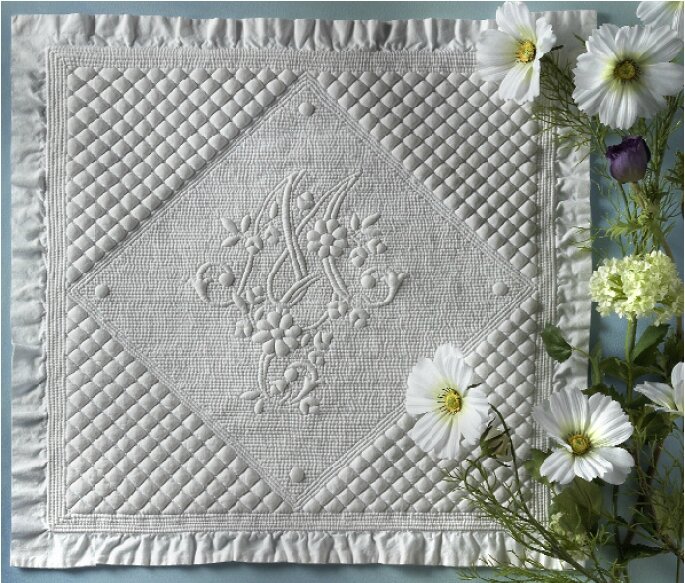Short introduction to be sure we’re talking about the same thing:
Pay attention: there are boutis and BOUTIS !
Boutis currently sold in our decoration shops, mail order catalogues and in other supermarkets are only simple quilted blankets made thanks to much simpler technique (3 layers of fabric stitched together) and which gives much less relief to the work.
This is an identity theft !
My first boutis (47 x 47 cm), on batiste and handemade.
In order to make a real Provençal boutis, first you have to stitch your two fabrics together along all the drawing.
When the work is fully stitched, you can start the padding to give the desired relief.
To do this, turn the work upside down and, at the base of each area and using a short stich of boxwood, a splinter forceps or a pin, spread the weft of the fabric without breaking fibers in order to get a small hole.
Thus you can insert the cotton wicks between the two layers of the fabric.
Once an element of the pattern has the good relief, the hole can be closed by placing the thread of warp and weft in their initial position with a needle and do so for all the work. It will become a real low relief.
Personally I changed this traditional technique, particularly by using the sewing machine and by working on coloured silk (whereas the old boutis are usually made of batiste).
I found inspiration themes more varied and more in harmony with the trends of contemporary design.
I wasn’t afraid to mix different techniques and materials.
This is how I see the boutis …
ABOUT SILK :
All the proposed works are almost all made of wild self-coloured silk (with irrégularrities in weaving) because this material offers a wild rang of colours.
And once highlighted, it catches the light in avert spécial way resulting in a satin-like quilt appearance.
Of course you can replace silk and batiste with plain cotton or percale but you should know that unlike the conventional wisdom, wild silk is worked very easily, is not delicate, do not crumple and above all it is soft to the touch.
If you use wild silk for the top of the work, use the batiste for the background because it would be too difficult to fill up the holes made in silk when the padding will be ended.
If your silk work is stained, dry cleaning is recommended but the best thing would be to take care throughout their production (to work in a clean place, remove coffee mugs and children's pens, and so on ...) thus you will not have to wash the work in the end.
I advise you to refer to my partner website if you want to learn more about the silk care :
AU VER A SOIE
